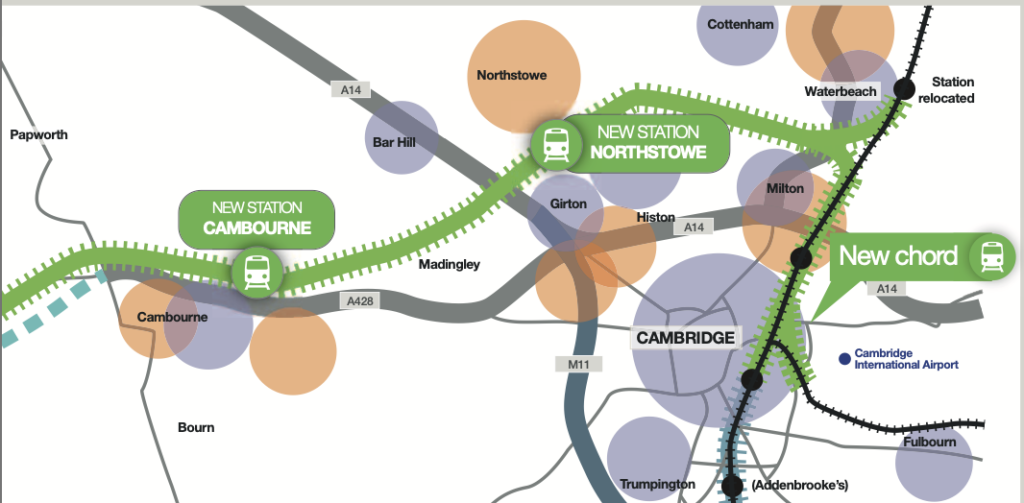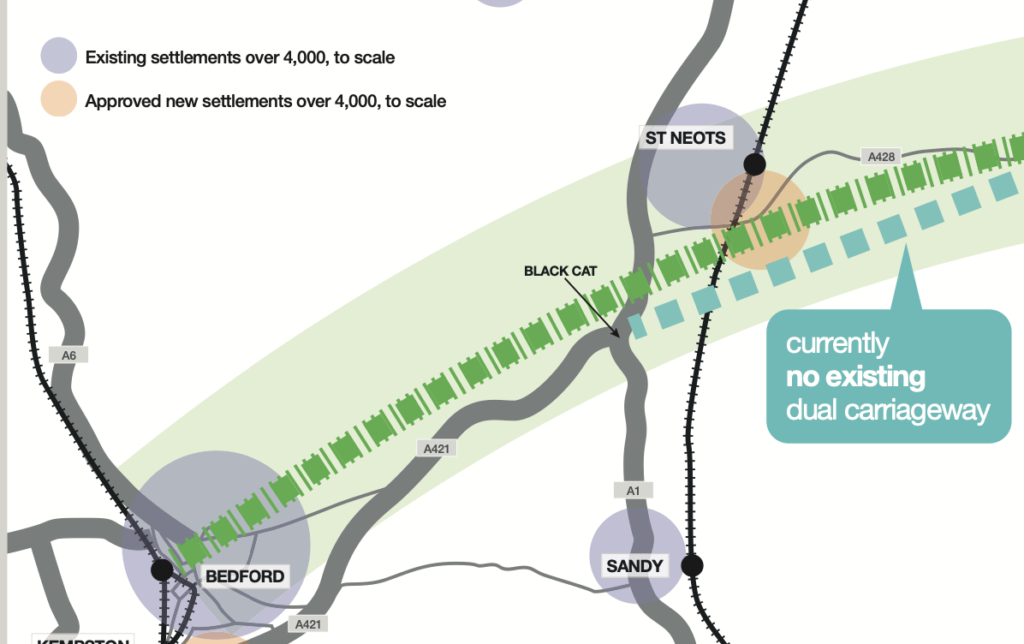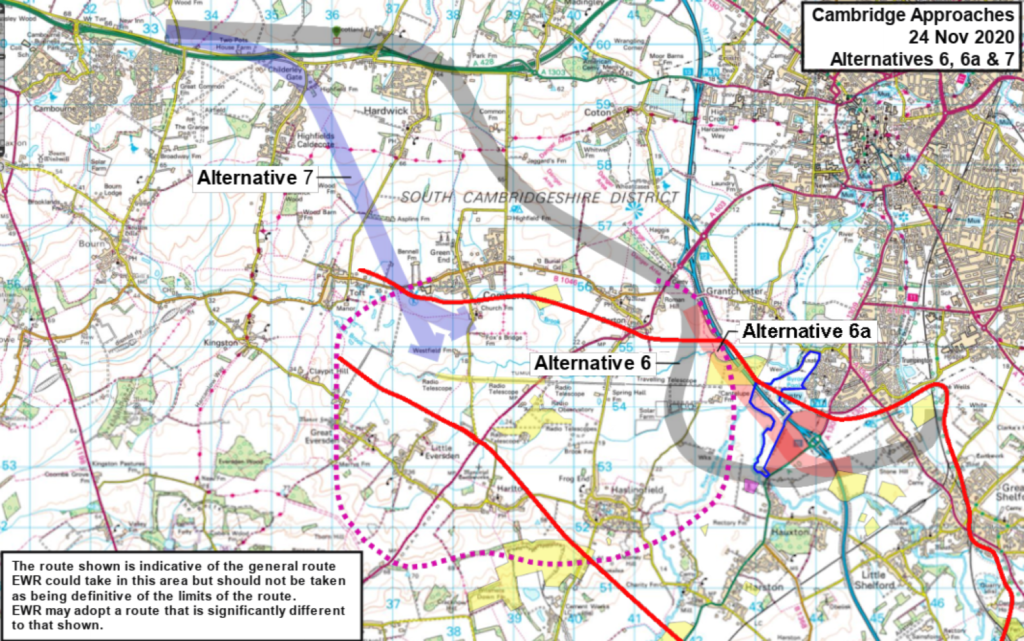**** For people new to this website: Cambridge Approaches favours a northern approach to Cambridge. Routes in this post are showing what might happen if we don’t do anything. They are not routes that are endorsed by Cambridge Approaches. ***

East West Rail’s Option E has located the Cambourne station to the south of the town. We think this is a misguided and short-sighted proposal that would fail to deliver potential commercial benefits, be more inconvenient for passengers and damaging to the environment.
The prime reason for this is that a station to the south, near Caxton, is completely impractical for the current housing and for the planned housing developments at West Cambourne and Bourn Airfield as well as expected developments to the north. Locating the station to the north of the A428 would not only unlock commercial benefits for the town in terms of land values but also reduce the number and length of commuter car trips required to the station. It would allow the area to be more easily developed according to the local plan and the wishes of local people who may not care about an extra 2 minutes to get to Oxford because, frankly, they very rarely go there anyway.
A transport hub north of the A428 connecting the CAM (the proposed metro system) and C2C (the proposed Cambourne to Cambridge busway), which both plan to follow the A428 near Cambourne, and a north Cambourne EWR station would provide an efficient overall transport system between homes and workplaces. The ‘multi-modal corridor’ (i.e. running different forms of transport in one corridor) objective of the OxCam Arc could be supported by an EWR station close to the A428 expressway north of Cambourne. Although an alternative C2C route has recently been suggested to connect to a south Cambourne station, it would need to cut across green recreational parkland areas within Cambourne – clearly undesirable.
Such a northern station also allows EWR total flexibility in the choice of a northerly or southerly approach into Cambridge – a station in south Cambourne would effectively lock EWR into a southerly route. While EWR’s current proposal (part of their Option E) is to enter Cambridge via the proposed Cambridge South station, they have accepted, recently more openly, that there is a case for entering Cambridge via Cambridge North. This route would serve communities in Northstowe, Oakington and the many planned developments in this area, and hence improve the currently poor business case, as well as minimising the environmental damage that a new rail line will cause.

By locating the station to the north of the A428, the EWR line would not need to cross the planned A428 expressway between the Black Cat and Caxton Gibbet roundabouts (i.e. to the west of Cambourne) and so dispense with a major design interface which is all too often the cause of significant cost overruns and programme delays.

The environment too would benefit from a north Cambourne station. By integrating the station with the local housing developments, the visual impact could be reduced compared to a station in open countryside. The route out of a north Cambourne station towards Cambridge should follow the A428 for several miles, whichever approach into Cambridge is finally adopted. This multi-modal alignment would have less impact on wildlife, including the legally protected Special Area of Conservation at Wimpole and Eversden and the foraging and flight lines of the Barbastelle bats, all over the current Option E area than if the road and rail ran along separate routes. The same can be said of the route from a Cambourne north station west towards Bedford where there is an opportunity for a multi-modal corridor all the way to the Black Cat Roundabout, a distance of over 17 miles. Other advantages of multi-modal corridors include less damage to precious farmland, less disturbance to rural villages and less severance of important links between villages e.g. for school children, not to mention the MRAO planning exclusion zone. We have highlighted the advantages of multi-modal corridors before along with our example route to Cambridge South.

This Cambourne North Station proposal is strongly supported by Cambourne Town Council, members of South Cambridgeshire District Council and local MP Anthony Browne. It was also a core component of the popular CBRR proposal. It has so many advantages over the current Option E solution.
It may be possible to have a Cambourne North Station and a route around the edge of Bourn Airfield and then back on to the option E line (see alternative 7 above). We have some reports that this is what EWR Co. are planning. Public recording of survey evidence and the strange assumption we understand (from Anthony Browne’s constituency office) that EWR Co. are making about not needing to double the busy Cambridge Line south of Shepreth Branch junction point to something like our alternative 4 route for the approach to Cambridge south. This would be an environmental and planning blight disaster for our area and not make full use of the possible multi-modal corridors. There is an opportunity for EWR Co. to do the right thing by the communities they aim to serve and in the process provide some sorely needed improvement to the weak business case for their railway that we will all be paying for.
We will have to wait until the New Year before we know whether EWR also see the sense of this.
7 replies on “The Case for an EWR Cambourne North Station”
Does the proposed closure and redevelopment of Cambridge Airport (May 2019 announcement that airport would be closed to all traffic by 2030 at the latest with plans to redevelop the airport site for around 12,000 homes and 5 million sq ft (0.46 million m2) of business premises) provide any additional support for a route into the north of the City?
Yes surely it does. The Eastern Access consultation should take account of this and the projected use of the branch line to Newmarket to get freight to Felixstowe… https://consultcambs.uk.engagementhq.com/cea-consultation-2020 being
Congratulations on your research and very convincing proposal for Cambourne North coming into Cambridge North…..so much more logical as will be appreciated by future generations. This proposakl must be taken into account by EWR.
Clearly you don’t live in the area north of Cambourne, if you did you would appreciate that this is a beautiful area of unspoilt land currently protected by the A428.
We’ll have electric self driving cars for our future generations there is no point in building a railway running old tech diesel trains and digging up 1000’s of acres of land to build it, a widening of the existing Caxton-St Neots road will make the greatest difference to everyone rather than just a few.
I’ve very concerned about this impending distaster that is coming our way.
Paul
We are deeply skeptical about the case for the railway as part of the OxCam Arc, where it is proposed to practically double the number of houses in Cambridgeshire by 2050. Assuming that the railway does happen we are campaigning for a fair consultation, which we have not yet had.
The argument supporting a North Station omits the impact on the green field environment and the inevitable additional housing that will be associated with this idea. This creates severe pressure on the traditional villages environment that make South Cambs so attractive e.g. Elsworth, Boxworth, Knapwell Connington etc. It cannot be desirable to allow new build housing to swamp all and thus far the A428 has provided a natural buffer to this.
Unintended consequences?
A station for Cambourne north of the A428 seems a necessary prerequisite for the northern approach to work and, wholly or partly through the pressure brought to bear by Cambridge Approaches, CBRR, Cambourne TC and our MP, you have been able to get EWR to declare an emerging preference for just that.
Of course, wherever a new station is located development will inevitably follow. In the case of the ill-named ‘North Cambourne’ – it might more accurately be called Knapwell station as that is the parish in which it would be located – the developers have in mind up to 10,000 houses which would mean something in the region of 30,000 people (plus their thousands of cars).
However, if EWR sticks to its guns and ends up building the line after Cambourne/Knapwell station across the 428 and through Caldecote Highfields, what will have been achieved? ‘North Cambourne’ is not an organic outgrowth of Cambourne, so let’s call it what it would be – a large new town in South Cambs (‘Thakeham North’ perhaps?), an area which has already borne more than its fair share of new development, and another step towards the urbanisation of the A428 Corridor towards Cambridge.
Isn’t it time an end was made to the divisiveness in South Cambs which has arisen from the entrenched arguments about route alignments and we all united to campaign for a reappraisal of the EWR link and some modicum of coherence in the various transport schemes suggested for our area?